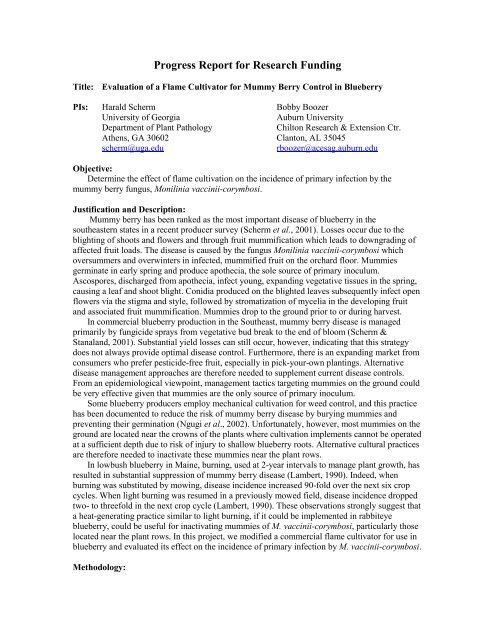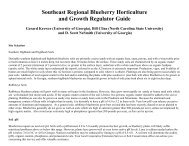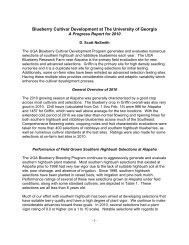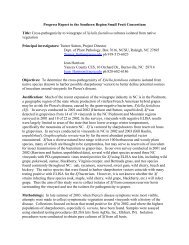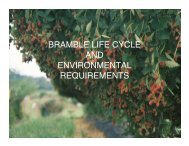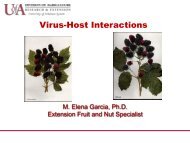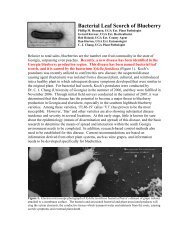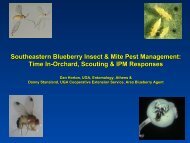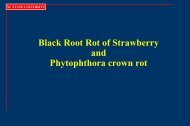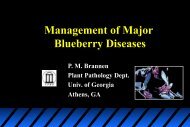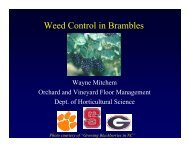Progress Report for Research Funding
Progress Report for Research Funding
Progress Report for Research Funding
- No tags were found...
Create successful ePaper yourself
Turn your PDF publications into a flip-book with our unique Google optimized e-Paper software.
<strong>Progress</strong> <strong>Report</strong> <strong>for</strong> <strong>Research</strong> <strong>Funding</strong>Title: Evaluation of a Flame Cultivator <strong>for</strong> Mummy Berry Control in BlueberryPIs: Harald Scherm Bobby BoozerUniversity of GeorgiaAuburn UniversityDepartment of Plant PathologyChilton <strong>Research</strong> & Extension Ctr.Athens, GA 30602 Clanton, AL 35045scherm@uga.edurboozer@acesag.auburn.eduObjective:Determine the effect of flame cultivation on the incidence of primary infection by themummy berry fungus, Monilinia vaccinii-corymbosi.Justification and Description:Mummy berry has been ranked as the most important disease of blueberry in thesoutheastern states in a recent producer survey (Scherm et al., 2001). Losses occur due to theblighting of shoots and flowers and through fruit mummification which leads to downgrading ofaffected fruit loads. The disease is caused by the fungus Monilinia vaccinii-corymbosi whichoversummers and overwinters in infected, mummified fruit on the orchard floor. Mummiesgerminate in early spring and produce apothecia, the sole source of primary inoculum.Ascospores, discharged from apothecia, infect young, expanding vegetative tissues in the spring,causing a leaf and shoot blight. Conidia produced on the blighted leaves subsequently infect openflowers via the stigma and style, followed by stromatization of mycelia in the developing fruitand associated fruit mummification. Mummies drop to the ground prior to or during harvest.In commercial blueberry production in the Southeast, mummy berry disease is managedprimarily by fungicide sprays from vegetative bud break to the end of bloom (Scherm &Stanaland, 2001). Substantial yield losses can still occur, however, indicating that this strategydoes not always provide optimal disease control. Furthermore, there is an expanding market fromconsumers who prefer pesticide-free fruit, especially in pick-your-own plantings. Alternativedisease management approaches are there<strong>for</strong>e needed to supplement current disease controls.From an epidemiological viewpoint, management tactics targeting mummies on the ground couldbe very effective given that mummies are the only source of primary inoculum.Some blueberry producers employ mechanical cultivation <strong>for</strong> weed control, and this practicehas been documented to reduce the risk of mummy berry disease by burying mummies andpreventing their germination (Ngugi et al., 2002). Un<strong>for</strong>tunately, however, most mummies on theground are located near the crowns of the plants where cultivation implements cannot be operatedat a sufficient depth due to risk of injury to shallow blueberry roots. Alternative cultural practicesare there<strong>for</strong>e needed to inactivate these mummies near the plant rows.In lowbush blueberry in Maine, burning, used at 2-year intervals to manage plant growth, hasresulted in substantial suppression of mummy berry disease (Lambert, 1990). Indeed, whenburning was substituted by mowing, disease incidence increased 90-fold over the next six cropcycles. When light burning was resumed in a previously mowed field, disease incidence droppedtwo- to threefold in the next crop cycle (Lambert, 1990). These observations strongly suggest thata heat-generating practice similar to light burning, if it could be implemented in rabbiteyeblueberry, could be useful <strong>for</strong> inactivating mummies of M. vaccinii-corymbosi, particularly thoselocated near the plant rows. In this project, we modified a commercial flame cultivator <strong>for</strong> use inblueberry and evaluated its effect on the incidence of primary infection by M. vaccinii-corymbosi.Methodology:
Flame cultivator design: A propane-operated four-burner unit (Flame Engineering, Inc.,LaCrosse, KS) was modified by mounting the burners on a hydraulically retractable arm on asmall four-wheel trailer (Fig. 1). During operation, the trailer was pulled behind a tractortraveling at a speed of 3.9 to 4.9 km h −1 along the row middle, while the retractable arm allowedthe working distance to the treated plant row to be adjusted. The unit required two individuals <strong>for</strong>operation, one to drive the tractor and a second person to engage the burners and to adjust theworking distance. The burners provided flame coverage in a 0.9-m swath next to the plant row.Experiment I (Social Circle, GA): This site was a pick-your-own blueberry planting with ahistory of severe mummy berry disease. Treatment plots were established along four adjacentrows of mature ‘Brightwell’ and ‘Tifblue’ plants. Each row was separated into three blocks(replications), each of which was further subdivided into two plots with or without application offlame cultivation. Each plot was two rows wide and ten bushes long. Flame treatments wereapplied to both sides of each row on March 12, 20, and 27. Average leaf bud stage (NeSmith etal., 1998) on March 19 and 27 was 3.0 and 4.6 <strong>for</strong> ‘Brightwell’ and 2.9 and 4.5 <strong>for</strong> ‘Tifblue’,respectively. No fungicides were used during the experimental period. Incidence of primaryinfection by M. vaccinii-corymbosi was determined on April 5, 11, 17, and 25 by counting thenumber of newly blighted shoots (‘strikes’) on three bushes in the center of each plot; countswere made only on one side of each bush. Values were totaled <strong>for</strong> the four assessment dates andexpressed as cumulative number of strikes per bush. We were unable to directly assess the effectof flaming on mummies on the ground due to a low density of mummies in the planting.Experiment II (Sterrett, AL): The area selected <strong>for</strong> treatment consisted of five adjacent rowsin a mature planting of rabbiteye blueberry. One row of ‘Climax’ in the center of the area wasutilized <strong>for</strong> data collection. Individual plots were eight bushes long and arranged in a randomizedcomplete block design with two treatments (with or without flaming) and three replications. Nofungicides were applied during the experimental period. Flame treatments were made on March14 and 26. An earlier treatment planned <strong>for</strong> March 7 had to be discontinued due to high firehazard -- the planting harbored a high population of overwintered annual grasses which readilyignited under dry conditions. Mummies collected from this planting were observed to produceapothecia in mid-March. On April 10, the number of strikes in five randomly selected samplesites per plot was counted; each sample site consisted of a 0.3 × 0.3-m 2 canopy area.Results:Disease pressure was very high at the two sites. For example, untreated control plots of‘Brightwell’ in the GA planting had close to 170 strikes per bush on average. Under theseconditions, flame cultivation did not reduce disease incidence significantly (Table 1). In the ALplanting, flame treatments reduced strike numbers by 43% on average (Table 1), but even thisreduction was not statistically significant (P > 0.22).Conclusions and Impact:Our attempts in utilizing a flame cultivator to inactivate mummies and thus reduce theincidence of primary infection met with limited success. Various factors could have beenresponsible:• Disease pressure in both plantings may have been too high <strong>for</strong> control strategies targetedagainst initial inoculum to be effective.• While the burner unit was able to operate close to the plant row, a strip centered in the rowmiddle remained untreated. Mummies in this area could have provided inoculum <strong>for</strong> primaryinfection. Perhaps the use of mechanical cultivation in the row middles in combination withflame cultivation along the rows could lead to more pronounced disease suppression.• The soil surface in both plantings was covered with vegetation (sod and weeds) which mayhave protected the mummies on the ground from receiving sufficient heat exposure. Flame
cultivation may be more successful when applied to a bare soil surface.• The presence of overwintered, combustible grasses in the AL planting prevented us fromapplying flame treatments during dry conditions. Thus, treatments could not always beapplied at sufficiently close intervals in a timely manner.• Although the plots used in this study were relatively large, inoculum from nearby controlplots could have contributed to infection in the treated plots.As long as these issues remain unresolved, flame cultivation has limited potential <strong>for</strong>practical use in a mummy berry control program.Literature Cited:Lambert, D.H. 1990. Plant Disease 74:199-201.NeSmith, D.S., Krewer, G., and Williamson, J.G. 1998. HortScience 33:757.Ngugi, H.K., Scherm, H., and NeSmith, D.S. 2002. Phytopathology 92:877-883.Scherm, H., NeSmith, D.S., Horton, D.L., and Krewer, G. 2001. Small Fruits Review 1(4):17-28.Scherm, H., and Stanaland, R.D. 2001. Small Fruits Review 1(3):69-81.Table 1. Incidence of primary infection by Monilinia vaccinii-corymbosi in plots of rabbiteyeblueberry that were either treated or not treated with a flame cultivator in March.Social Circle, GA aSterrett, AL bTreatment ‘Brightwell’ ‘Tifblue’ ‘Climax’Flame-cultivated 162.8 ± 46.9 109.0 ± 25.5 5.7 ± 1.6Untreated control 167.9 ± 52.5 118.7 ± 43.9 10.0 ± 3.8LSD (α = 0.05) 54.1 80.7 10.7aValues are means and standard errors of numbers of strikes per bush based on three replicateplots with three bushes assessed per plot. Counts were made only on one side of each bush.bValues are means and standard errors of numbers of strikes per 0.09-m 2 canopy area based onthree replicate plots with five sample sites assessed per plot.ACBFig. 1. Modified flamecultivator unit evaluated <strong>for</strong>suppression of mummy berrydisease. Overall view of the unit(A); close-up view of a test runon a grassy surface (B);operation of the unit in ablueberry planting (C).


